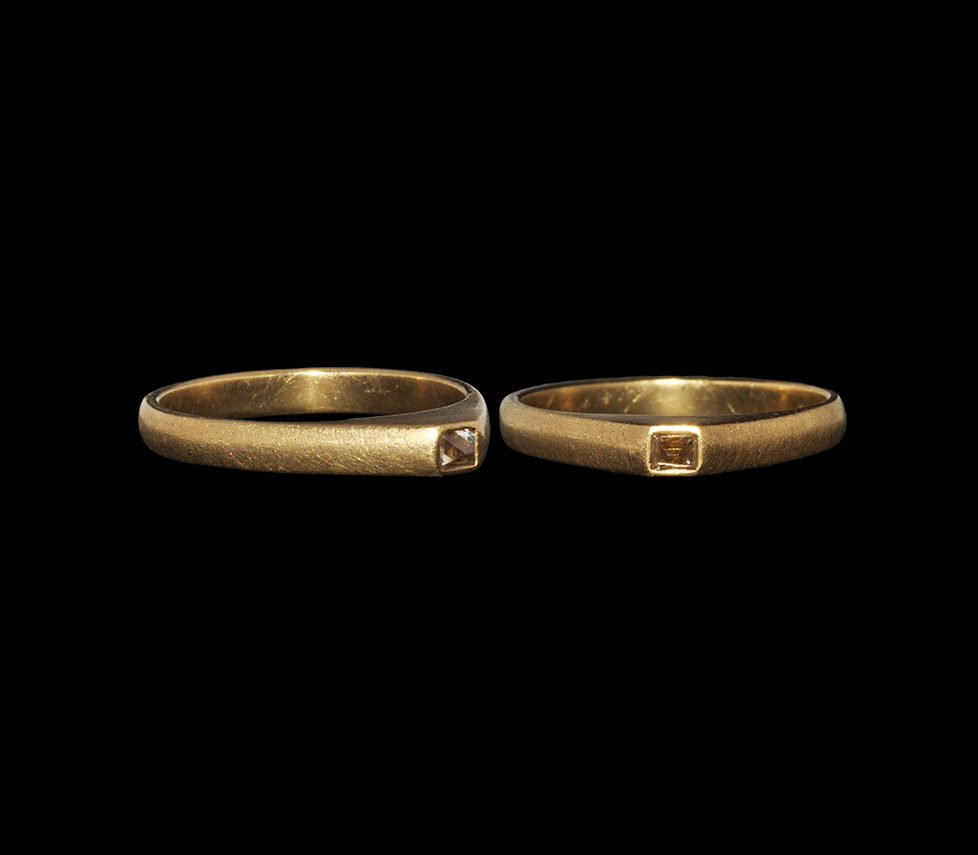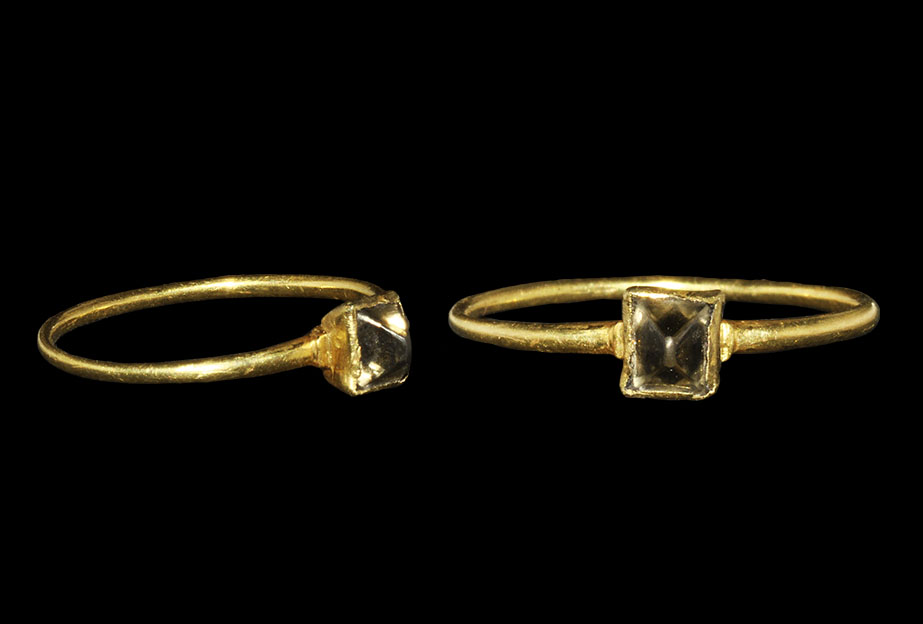MANILIUS, Marcus (fl. early 1st century). Astronomicon . Nuremberg: Johannes Müller (Regiomontanus), [ca. 1472-74]. Chancery 4° (208 x 149mm). Collation: [1-6 1 2 ] (1/1 text, 6/12v colophon). 72 leaves. 30 lines. Type 1:94 . R. Woodcut initials (44 x 44mm) opening each book, other 2- and 3-line initial spaces with guide-letters. (Corners and margins of several leaves repaired, fos.50 and 69 remargined on two sides, some marginal scribbles washed.) Gold-tooled green morocco over pasteboard, sides panelled with roll-tool and corner ornaments, spine tooled in compartments, gilt turn-ins, yellow glazed endpapers, gilt edges, bound by Charles Lewis for Botfield, for which (plus 12 hours cleaning) he was paid #1.8.0. Provenance : Richard Heber (1773-1833, sale pt.1, Sotheby's, April 1834, no.4350, #15.5.0 to Payne); bought by Botfield from Payne and Foss for #18.18.0, then still in quarter russia (P. & F. Acquisitions, p.59v). FIRST EDITION. The Astronomicon must have been among the earlier publications of Regiomontanus at Nuremberg, because it was included as already printed in the advertisement that listed the Ephemerides , dated 1474, as nearly finished. The other book in that list which is stated as already completed is what was probably the first book Regiomontanus printed, the Theoricae novae planetarum by Peuerbach, Regiomontanus's former teacher at Vienna. This Nuremberg edition of the Astronomicon and the Bologna edition printed by Ugo Rugerius in 1474 were printed from independent exemplars. The great modern editor of this work, A.E. Housman, considered this Nuremberg edition to be not only earlier than, but superior to the Bologna edition, and believed that Regiomontanus must have corrected the manuscript exemplar himself, as so many of the corrections are not to be found in any surviving manuscript (Housman, V, p.xvii). The rarity of this edition is proved by the fact that neither of Manilius's other great editors, Scaliger and Bentley, knew of it, and so Regiomontanus's corrections were incorporated into the text only in this century. Regiomontanus established at Nuremberg the first European observatory and a laboratory for the construction of scientific instruments. Another activity of this scientific foundation was the printing of books on related subjects, particularly calendars. The Astronomicon describes creation and the heavens, the signs of the zodiac, and astral influences on human beings. Regiomontanus left Nuremberg by the autumn of 1475 when he was called to Rome by Sixtus IV to help reform the calendar. The decorated initials are Roman in design and appear to have been copied from a set used by Sweynheym and Pannartz in 1471 and by Herolt and Riessinger in the 1480s. Folios 11 and 12 have been misbound between fos. 2 and 3. H *10703; BMC II, 456 (IA. 7874-5); Goff M-202; Klebs 661.1; IGI 6125; Flodr, Manilius 1
MANILIUS, Marcus (fl. early 1st century). Astronomicon . Nuremberg: Johannes Müller (Regiomontanus), [ca. 1472-74]. Chancery 4° (208 x 149mm). Collation: [1-6 1 2 ] (1/1 text, 6/12v colophon). 72 leaves. 30 lines. Type 1:94 . R. Woodcut initials (44 x 44mm) opening each book, other 2- and 3-line initial spaces with guide-letters. (Corners and margins of several leaves repaired, fos.50 and 69 remargined on two sides, some marginal scribbles washed.) Gold-tooled green morocco over pasteboard, sides panelled with roll-tool and corner ornaments, spine tooled in compartments, gilt turn-ins, yellow glazed endpapers, gilt edges, bound by Charles Lewis for Botfield, for which (plus 12 hours cleaning) he was paid #1.8.0. Provenance : Richard Heber (1773-1833, sale pt.1, Sotheby's, April 1834, no.4350, #15.5.0 to Payne); bought by Botfield from Payne and Foss for #18.18.0, then still in quarter russia (P. & F. Acquisitions, p.59v). FIRST EDITION. The Astronomicon must have been among the earlier publications of Regiomontanus at Nuremberg, because it was included as already printed in the advertisement that listed the Ephemerides , dated 1474, as nearly finished. The other book in that list which is stated as already completed is what was probably the first book Regiomontanus printed, the Theoricae novae planetarum by Peuerbach, Regiomontanus's former teacher at Vienna. This Nuremberg edition of the Astronomicon and the Bologna edition printed by Ugo Rugerius in 1474 were printed from independent exemplars. The great modern editor of this work, A.E. Housman, considered this Nuremberg edition to be not only earlier than, but superior to the Bologna edition, and believed that Regiomontanus must have corrected the manuscript exemplar himself, as so many of the corrections are not to be found in any surviving manuscript (Housman, V, p.xvii). The rarity of this edition is proved by the fact that neither of Manilius's other great editors, Scaliger and Bentley, knew of it, and so Regiomontanus's corrections were incorporated into the text only in this century. Regiomontanus established at Nuremberg the first European observatory and a laboratory for the construction of scientific instruments. Another activity of this scientific foundation was the printing of books on related subjects, particularly calendars. The Astronomicon describes creation and the heavens, the signs of the zodiac, and astral influences on human beings. Regiomontanus left Nuremberg by the autumn of 1475 when he was called to Rome by Sixtus IV to help reform the calendar. The decorated initials are Roman in design and appear to have been copied from a set used by Sweynheym and Pannartz in 1471 and by Herolt and Riessinger in the 1480s. Folios 11 and 12 have been misbound between fos. 2 and 3. H *10703; BMC II, 456 (IA. 7874-5); Goff M-202; Klebs 661.1; IGI 6125; Flodr, Manilius 1







Try LotSearch and its premium features for 7 days - without any costs!
Be notified automatically about new items in upcoming auctions.
Create an alert